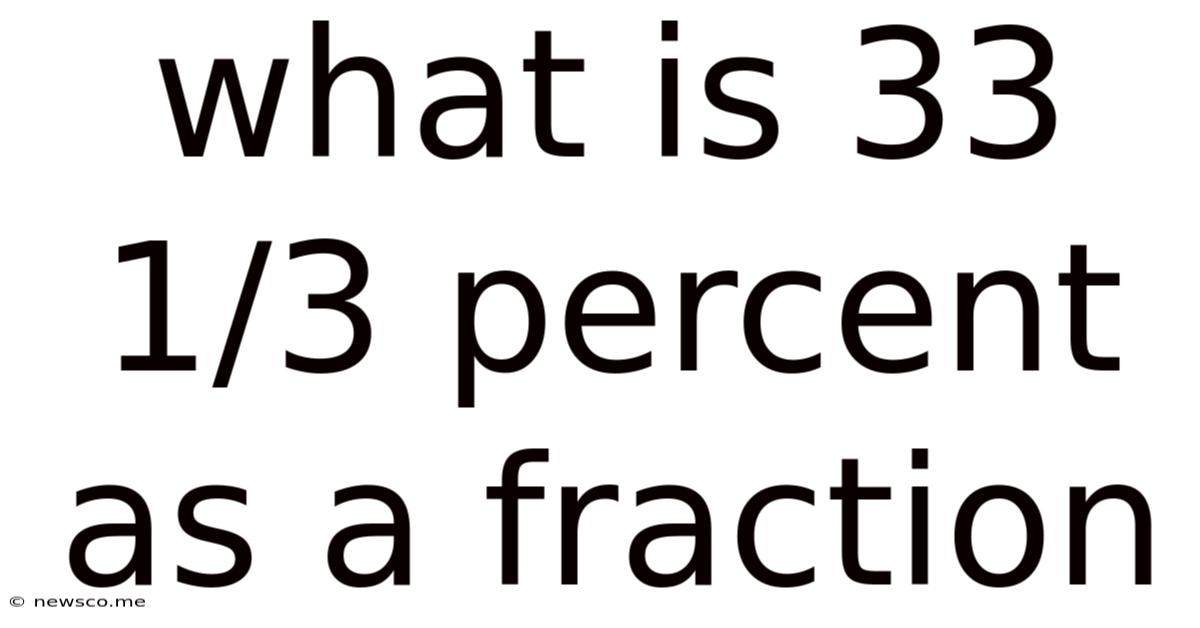What Is 33 1/3 Percent As A Fraction
News Co
Apr 02, 2025 · 4 min read

Table of Contents
What is 33 1/3 Percent as a Fraction? A Comprehensive Guide
Understanding percentages, fractions, and decimals is fundamental to various aspects of life, from calculating discounts to understanding financial reports. This comprehensive guide will delve into the conversion of 33 1/3 percent into a fraction, explaining the process in detail and providing additional examples to solidify your understanding. We'll also explore the practical applications of this conversion and address common misconceptions.
Understanding Percentages and Fractions
Before we dive into the conversion, let's refresh our understanding of percentages and fractions.
Percentages: A percentage is a way of expressing a number as a fraction of 100. The symbol "%" denotes percentage. For instance, 50% means 50 out of 100, or 50/100.
Fractions: A fraction represents a part of a whole. It consists of a numerator (the top number) and a denominator (the bottom number). The numerator indicates how many parts you have, and the denominator indicates how many parts make up the whole. For example, in the fraction 3/4, 3 is the numerator and 4 is the denominator.
Converting 33 1/3 Percent to a Fraction: Step-by-Step
Converting 33 1/3% to a fraction involves several straightforward steps:
Step 1: Rewrite the percentage as a fraction over 100.
33 1/3% can be written as: (33 1/3) / 100
Step 2: Convert the mixed number (33 1/3) to an improper fraction.
To do this, multiply the whole number (33) by the denominator (3) and add the numerator (1). The result becomes the new numerator, and the denominator remains the same.
33 x 3 + 1 = 100
Therefore, 33 1/3 becomes 100/3.
Step 3: Substitute the improper fraction back into the expression.
Now our expression looks like this: (100/3) / 100
Step 4: Simplify the complex fraction.
Dividing by a fraction is the same as multiplying by its reciprocal. The reciprocal of 100 is 1/100. So, we can rewrite the expression as:
(100/3) x (1/100)
Step 5: Simplify the expression by canceling out common factors.
Notice that both the numerator (100) and the denominator (100) cancel each other out:
(100/3) x (1/100) = 1/3
Therefore, 33 1/3% as a fraction is 1/3.
Practical Applications of Converting Percentages to Fractions
The ability to convert percentages to fractions is crucial in various real-world scenarios:
1. Calculating Discounts and Sales Tax
Imagine a store offering a 33 1/3% discount. Knowing that this is equivalent to 1/3 makes calculating the discount much simpler. If an item costs $90, the discount is (1/3) x $90 = $30.
2. Solving Mathematical Problems
Many mathematical problems involve fractions, and understanding how to convert percentages to fractions is essential for solving them efficiently. For instance, calculating the fraction of a circle represented by a sector with a certain angle involves working with fractions and percentages.
3. Understanding Financial Statements
Financial reports often use percentages to express key metrics like profit margins and debt ratios. Converting these percentages into fractions can provide a clearer understanding of the financial health of a company.
4. Recipe Conversions
Cooking and baking often require adjusting recipes. If a recipe calls for a certain percentage of an ingredient and you need to scale it up or down, converting the percentage to a fraction simplifies the process. For example, reducing the sugar in a recipe by 33 1/3%.
Common Misconceptions and How to Avoid Them
Several common misconceptions can arise when dealing with percentage-to-fraction conversions:
1. Incorrectly Handling Mixed Numbers
A common mistake is failing to convert a mixed number (like 33 1/3) into an improper fraction before proceeding with the conversion. Always remember this crucial step.
2. Forgetting to Divide by 100
The percentage represents a fraction out of 100, so dividing by 100 is a necessary step that many overlook.
3. Improper Simplification
Failing to simplify the resulting fraction to its lowest terms can lead to inaccuracies and make further calculations more complex. Always simplify the fraction.
Extending the Concept: Other Percentage Conversions
The method used to convert 33 1/3% to a fraction can be applied to other percentages containing fractions:
- 25%: 25/100 = 1/4
- 50%: 50/100 = 1/2
- 75%: 75/100 = 3/4
- 16 2/3%: (16 2/3)/100 = (50/3)/100 = 1/6
- 66 2/3%: (66 2/3)/100 = (200/3)/100 = 2/3
Conclusion: Mastering Percentage to Fraction Conversions
Converting percentages to fractions is a fundamental skill with numerous practical applications. By understanding the steps involved and avoiding common misconceptions, you can confidently tackle various calculations involving percentages and fractions, improving your problem-solving abilities and enhancing your understanding of mathematical concepts in various fields. Remember to always simplify your final fraction to its lowest terms for accuracy and clarity. This comprehensive guide has provided you with the tools and knowledge necessary to master this essential skill.
Latest Posts
Related Post
Thank you for visiting our website which covers about What Is 33 1/3 Percent As A Fraction . We hope the information provided has been useful to you. Feel free to contact us if you have any questions or need further assistance. See you next time and don't miss to bookmark.